Colour Profiles
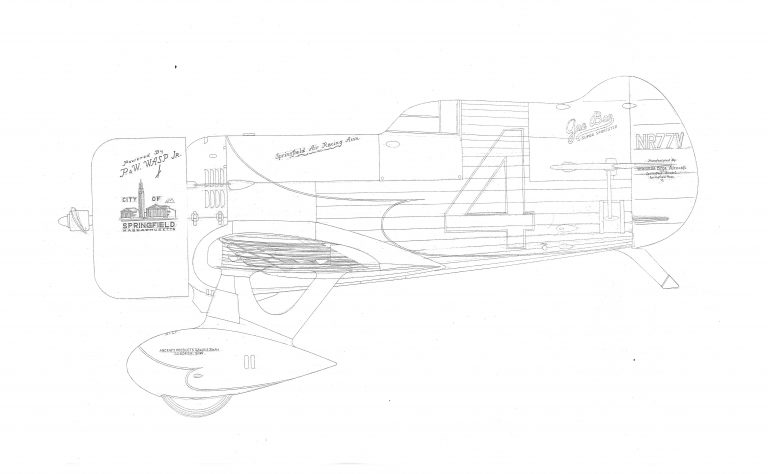
The Drawing, the picture…
At first, we will be needing some good scale-plans to draw one of these side-views (these are usually included in all monographs related to this airplane). Some publishing houses such as Kagero (Top Drawings) and MMP (Scale Plans) offer top-quality scale-drawings. Then, it is necessary to choose the best format and made an enlarged photocopy in order to achieve a basic decal and put it onto a canvas, which has been prepared in advance using some ‘gesso’. I follow the traditional steps: rubbing some graphite in dust form on the paper’s reverse and subsequently tracing the printed lines with a 6H-pencil.
Let focus on the drawing: I prefer to use a 4H-pencil to trace the shafts and fix the different measurements, the angles and the shapes but a 2H-pencil to trace the final lines. Working with top-quality tools is the key to achieve a good job: a ruler, a square, a compass but more particularly curved templates, circles, ellipses which are critical. The final picture is not merely a group of shapes and structural details, it also takes into consideration all elements which are a part of the airplane such as insignia or labels.
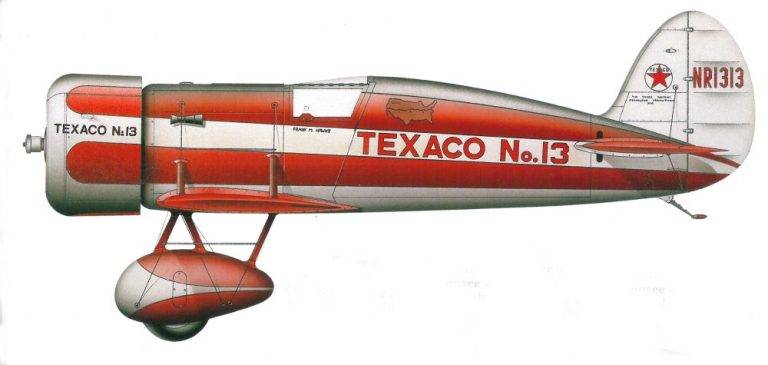
TRAVEL “AIR MISTERY SHIP”. Acrylic and Ink on Paper. 32×45 cm.
There were only five units made of that much beautiful racer designed in 1929. The illustration depicts the best known of all, the ‘Texaco No.13’. The pilot Frank Hawks achieved several distance and speed records. The Travel Air Company, which had designed the aircraft (in utmost secrecy), is the origin of the current Beech Aircraft.
These are really depictable airplanes, with their lines, so pure, with their eye-catching colourful camouflage patterns. The measurements perfectly fit to any small format. Nearly all of them had intricate labelling, race numbers or registration plates: this sort of details can surely make our work more complicated. The original illustration was published in the magazine EuroModelismo (No. 120) and belongs to a friend of mine, Jordi Escarré.
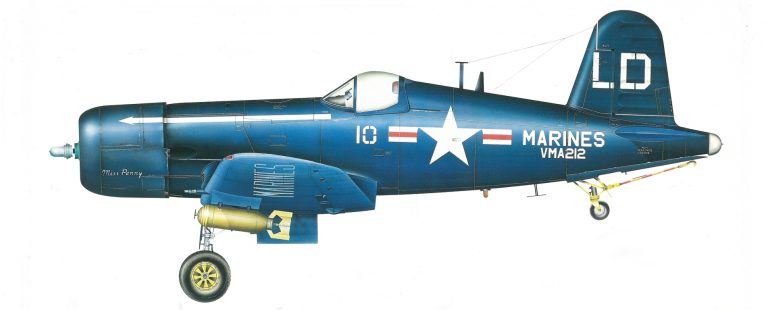
F4U/AU-1 CORSAIR – Acrylic on Schoellerhammer paper 45×65 cm.
Thin white lines are the most challenging issue when one makes aircraft side views, the tiny shine present in many airplane parts such as the joints of the panels or the rivets. No matter how much expertise and accuracy, no matter the top quality of the paintbrush, it always means tedious long work and a huge number of retouches.
I tried some Rotring Stylograph with white paint (white ink first then acrylic paint); a really quick and easy way of working which did not really sit well with me. The paint had to be highly diluted for the tip of the Stylograph not to get stuck with paint so the shine was so tenuous and blended with the rest of the colours. White diluted paint onto a red hue became an ugly pinkish shade. I also tried as many pencils as I could (watercolour pencils too) but some were too subtle while other could not be sharpened as much as necessary.
To make thin and accurate details of white shining I prefer scraping off the surface up to the canvas -which is the supporting board- it is undoubtedly a must. This is a simple solution so many watercolour painters use so often. Just lightly pressing with the tip of the blade onto any colour to get white thinnest lines: effortless. No ugly markings in the smooth surface of the paper. I use the same tool (X-Acto No11 Blade) to make these lines and to cut the masking tape. Once the tip of the blade is no longer sharp and does not cut the masking tape properly, I can use it to make lines. The tip can also be rounded or bevelled using sandpaper so the lines could be of different thickness. To make oval or circular shapes I can use templates. The tip of a needle assembled to a metallic handle really suits me.
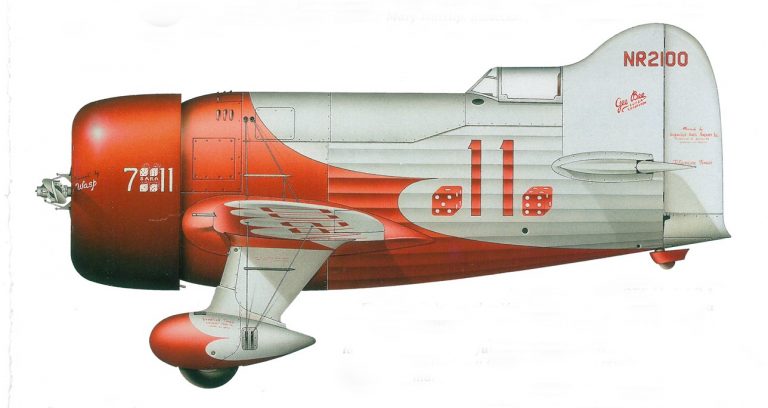
GEE BEE Model R-1 – Acrylic on paper, 35×50 cm.
The series of sports aircraft developed by Granville Brothers in the United States resulted in the very well-known and original R-1. We are showing the one with a famous pattern which won the Thompson Trophy Race in 1932.
The racing Gee Bees have always drawn my attention because of their much particular design and eye-catching painting schemes. I made good use of scale drawings done by Harry Robinson I had found in an old issue of the Aeromodeller magazine so I could set the main line drawing. Since I usually make the final drawing with a thin-tipped ballpoint pen I always try to go gentle so the black ink can turn to dark grey. The colours applied subsequently also tend to slightly veil these lines. Working this way the result is much better than making the draw with a pencil. Every tiny mistake can be corrected by softly scraping the surface of the canvas or the sheet of paper and this just using the tip of a blade. I got the whole set of colours highly diluted before applying the paints. I smeared a few glazing coats with the airbrush (the different shades depending on the number of layers). The white areas are given a final glazing of subtle yellow ochre. I also wanted to depict a very soft area surrounding the shadows (the area created by the wings, the tail plane and the fabric-covered airframe): I airbrushed the paint on the edge of a paper sheet -which I use as a masking- at some distance from the painting surface.
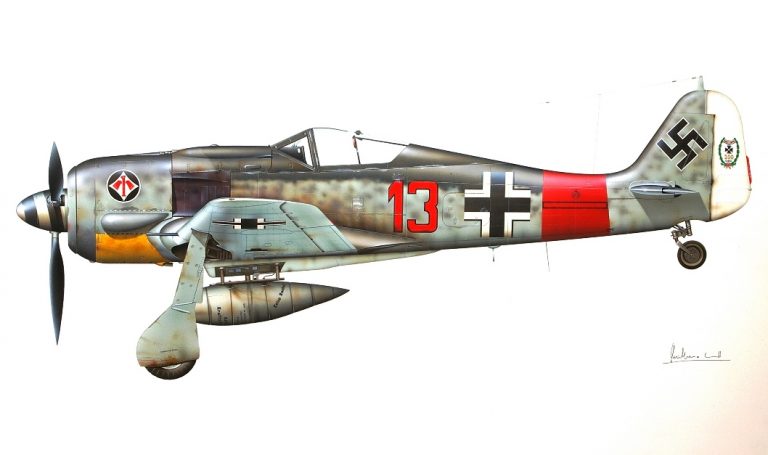
Luftwaffe Aces: FOCKE-WULF Fw.190 A-7 – Mixed Technique on board, 45 x 80 cm.
Despite it is a largely known fighter, I have never made an Fw.190 profile nor painted such a camouflage scheme. A most complicated aircraft in its shapes with so many tiny details which create subtle volumes with their own lights and shadows. Once I have collected as much information as possible, I have given it some serious thought (mainly due to a large number of Fw.190 variants with great number of camouflage patterns too). Finally, I have made up my mind and chosen one of the best known flying beasts: Major Oskar-Heinrich Bär’s “Red Thirteen” which got over 200 victories with this A-7 in April 1944 (a total number of 220 victories).
Along with all those historic facts related to this aircraft, the general painting scheme is really balanced: a wonderful camouflage made up of three different grey hues, a lighter one with some bluish shade, and different colour touches spread over the whole surface. The propeller spinner with its black and white strips, the cowling engine lower part painted yellow, the fighter wing JG.1, the numeral and the identification have been depicted too. I need to mention the vertical stabilizer painted white with some green-leaf border that showed all medals given to the Ace along with his victories (he was indeed a Luftwaffe Experte).
The aircraft has been painted onto a board previously prepared by applying a few layers of gesso, sanded off and polished. I am getting used to this kind of support, much more resistant than the drawing paper and much more versatile for any painting technique. I have achieved the drawing with a 2H-pencil, I have just enlarged a scale drawing. Then, I have achieved some minor corrections and added all those details which are not in the original scale drawing (like numerals, emblems…). As far as the general colour is concerned, I have tried to achieve the most realistic range of grey hues, so I have employed modelling paints. Next, I have made all the retouches with airbrush acrylic paints. Actually, a bunch of small details and effects have been finished with oil paints: using this kind of paints and working with a paintbrush has made my work accurate and natural.

FIAT CR-32Quater – Mixed Technique on board, 41 x 62 cm.
It has been a long while from the last time I painted a colour profile focussing on the Spanish Civil War. Lately, I was entrusted depicting this wonderful Fiat CR-32 belonging to 8-E-3 Fighter Squadron. The aircraft with license plate 3-144 was flown by Capitan Jose Pazo Montes, who commanded the unit from June to August 1938. Notice, in the tail section, the 8-E-3 emblem, a St. James Cross painted red onto a light blue shield. Note also, the squadron number with a slogan onto the wheel fairing.
As I have used a board to support the painting, I was forced to properly prepare it by applying a layer of gesso; this has finally allowed some oil diluted coats and transparencies. The previous airbrush work was made with acrylics paints, next I added some artwork using the paintbrush. We figure out this is the first time the “44” comes to light. (Alejandro Pazo’s private collection).
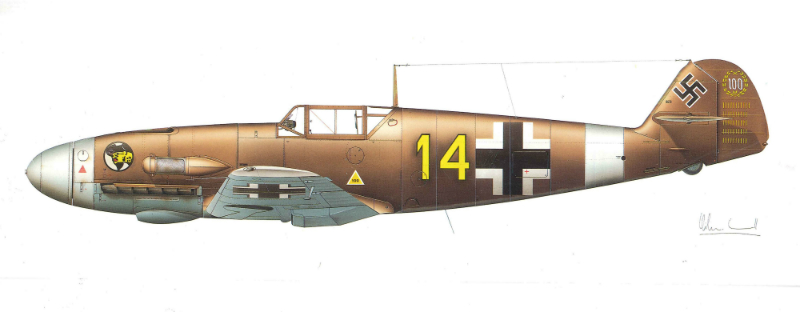
MESSERSCHMITT Bf.109F-2z/Trop, Acrylic on paper, 37 x 67.5-cm
It is not easy to exactly depict the lines of the Bf.109; in fact, in order to carry out this paintwork I was forced to prepare a template of curved shapes using a much cheap plastic ruler, sanding and polishing industriously the edges until reaching a rounded, open enough profile. Side views of aircraft, particularly the ones featuring WWII jets are much more colourful when the landing gear is extended and the hub is completed by the propeller blades. Nevertheless, this time I had to skip these details as the measurements of the drawing, specifically made to be published in an article devoted to the German Ace Hans-Joachim Marseille in Todo Modelismo magazine, had to be fitted into a particular space.
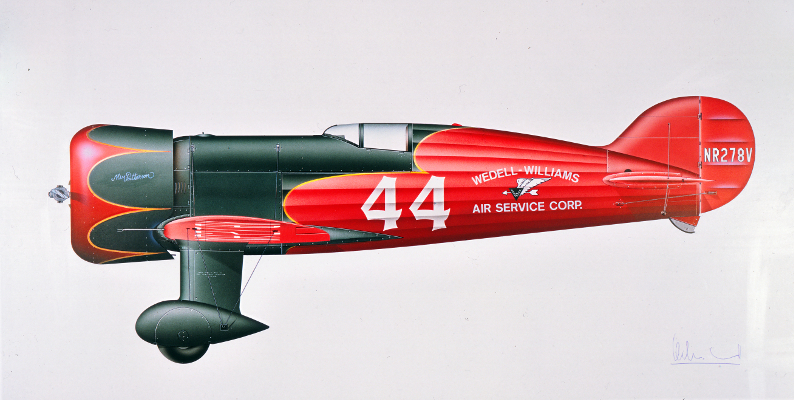
WEDELL-WILLIAMS RACER (private collection), Acrylic on paper, 43 x 25.5 cm
I have always been very fond of racing aircraft because of their refined and polished lines along with their striking paintwork. In this period I already was the editor-in-chief of Euro Modelismo magazine so I had somehow put aside this way of painting and got used to the oil painting but I took advantage of my spare time and I used to make profiles, very simple polished ones, with the airbrush tool. This painting is dated on November 1994 and it is the second of a six-profile series of painting featuring classic racers. Nowadays the paintings are scattered all over different countries since, unfortunately, I wasn’t capable of finding a collector interested in purchasing the complete series.

HEINKEL HE.112 BO (private collection), Acrylic on paper, 64.5 x 34 cm.
All the hobbyists fond of Spanish military aviation Know This He.112 flown by Lieutenant Miguel Train Klett, the shooting down Caused WHO of a USAF Lockheed P-38 in 1943 over North African territory. This drawing was made in March 1993 as a group of friends wanted to make a present to the very own Miguel Entrena. NEVERTHELESS, the ultimate owner is Jose Antonio Aranzabal, one of the best I have ever met collectors.
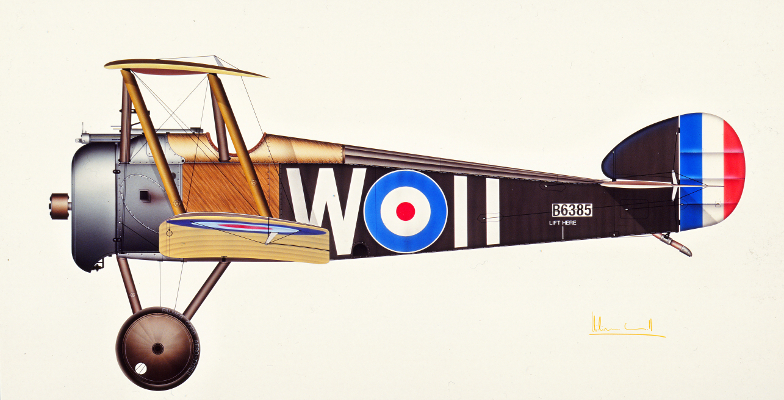
SOPWITH F.1 CAMEL (private collection), Acrylic on paper, 62 x 36.5 cm.
Somehow, transfers and numbers featuring letters Could be Adapted to Both the size and the Characteristics of the illustrations so I used them to depict small banners, billboards and numbering, all of These Accurately retouched to really integrate them in the drawing. This illustration is dated November 1992, it was an order from a customer Seville; Once We Agreed on the price I was absolutely free for choosing the kind of aircraft and the painting scheme. That’s why I do remember very fondly This work.
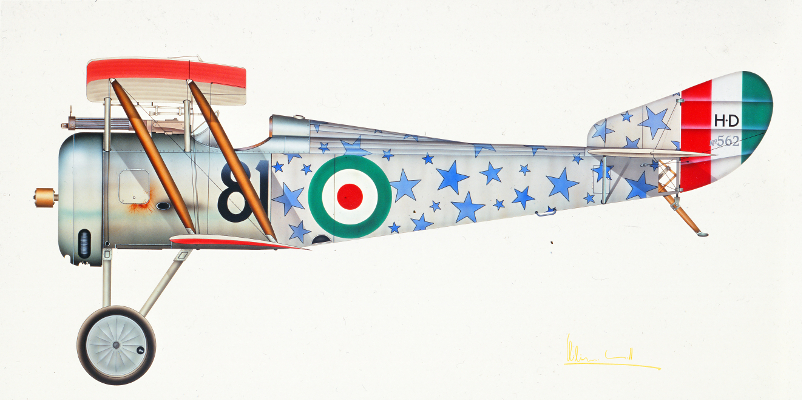
HANRIOT HD-1 (private collection) Ink and color pencil on paper, 59.2 x 40 cm.
I made this illustration in July 1991 and this is the only picture That still remains of esta period. I used to work With Holbein’s airbrush inks prior to discover Schmincke’s Aerocolor acrylic paints. Also I worked on Schoeller paper. This fighter Belonged to Lieutenant Antonio Bagliolo from 81st Squadriglia Caccia di italiana in 1918. The painting scheme is of one of the smartest and the original MOST I have ever seen. This illustration dated in July 1991 was a gift for my friend Miguel Angel Colomo.
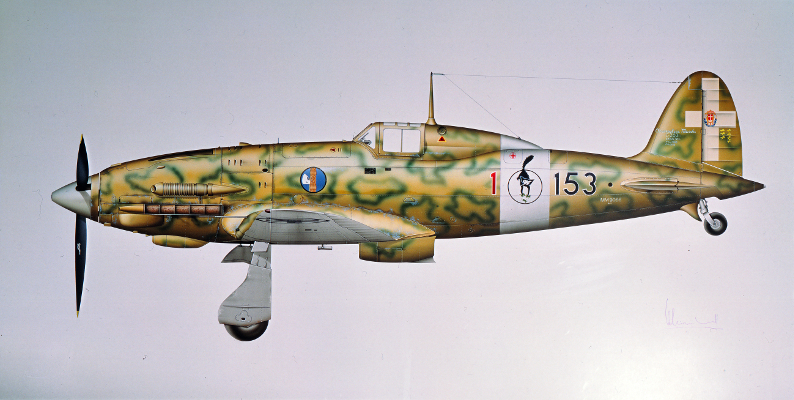
Macchi C.202 FOLGORE (private collection), Acrylic on paper, 69.6 x 44.3 cm.
In February 1995 I Had Already made a hundred color profiles of aircraft and the last one was esta gorgeous Italian WWII fighter. I have drawn four times esta aircraft. I advise all illustrators and painters dealing fond of aviation, Particularly When Working with an airbrush to try the exquisite camouflages used by the Regia Aeronautica on aircraft: such as the Folgore own, the MC.205 Veltro or CR.32 Both Fiat and Fiat G- 55. These airplanes Along With the ones in the Luftwaffe are an excellent way for practicing. As the drawing is somehow a bit special, made During one of the happiest periods of my life I preferred it to REMAIN Within the family so I gave it to my Dearly Beloved and never forgotten Andres Martinez Recuero.
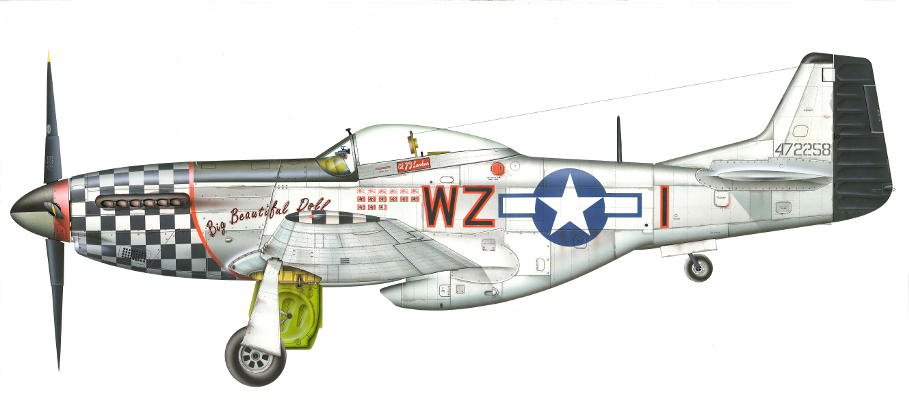
North American P-51D Mustang, Acrylic on paper, 70 x 36 cm.
The so-called profile or side view is the usual way to illustrate books and aviation magazines. These profiles are made nowadays digitally and some are top quality ones. ACCORDING to the deadlines today, it is impossible to work as we worked a few years ago, especially all those profiles When Were Carried out using a slow airbrushing technique. I need to point out, NEVERTHELESS, That computers, Which HAD led to abandon the old methods of painting, have later Given to airbrush ITS own importance. This mechanic tool has – been in question since the late 19 thcentury. The purists Have Alleged That Obtaining a perfect blurring by spraying a perfect mixture of air and paint is not credit, especially if Compared With the same effect Carried out using only paintbrushes: they May be right but They are wrong at some point Because When you know airbrushing good for you Realize That the airbrush tool really does not matter.
The more sets are masks and stencils, the better the work is. These stencils are used to create effects or to define the colors, so there is no trick, the whole work will depend on your hands and on your use of the tip of the blade. You simply draw using a blade.
As far as color profiles are concerned, there Were Always Been artists fond of diverse techniques. I’d like to remind you the drawings by Richard Caruana for Air International, by Don Greer for Signal Squadron and by Ray Rimell for Scale Models, but especially the ones by the Japanese artist Rikyu Watanabe Whose profiles were absolutely exceptional technique With His hyper realistic , first working for Tamiya and then a series of illustrating a splendid monographs published by Bonanza Books.
I made the P-51 Mustang side view in October 1992. The previous year, I was bound to save so much money to buy a silent compressor 150 Dalbe That is still working. I tried to airbrush tools few (Holbein, Paasche) but I still have (not in use, Although) my old and much beloved Iwata HP-B-0.2 With its mouth. Today it is really a collector’s item as the new model has-been redesigned. I had employed Holbein inks for my very first drawings These tend to bleach but remove Easily with light, Then I discovered the Schmincke’s AEROCOLOR Acrylics range, much better.
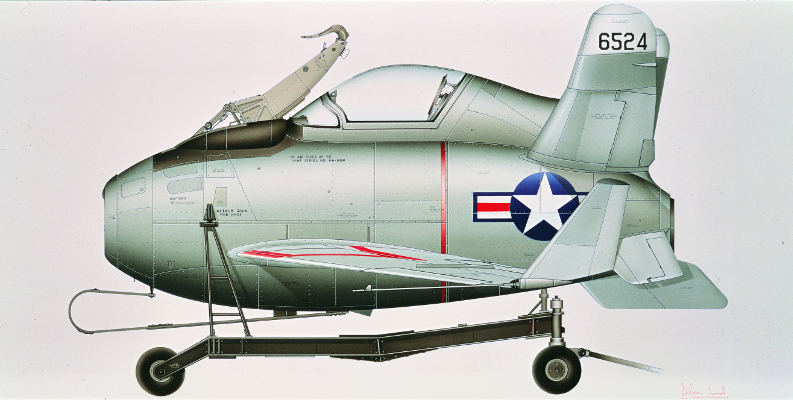
Mc DONNELL XF-85 GOBLIN (private collection), Acrylic on paper, 36.3 x 26 cm.
This tiny aircraft was designed as a “private” escorting fighter for the enormous Convair B-36 Peacemaker, and was fixed through a hook to the belly of the bomber; in case of attack it could get detached easily. Though a few tests were carried out, it was never in service.
In order to achieve a colourful painting, the hook is shown once opened; the airplane is assembled onto a transport platform used by ground crew as the Goblin had no landing gear.
This very simple work is dated in September 1994 and belongs to my friend Juan Manuel Villalba. Juan Manuel is undoubtedly, one of the best modellers I’ve ever met.
All the images are copyright (c) 2018 by Guillermo Coll. All right reserved. Copy and distribution are forbidden
